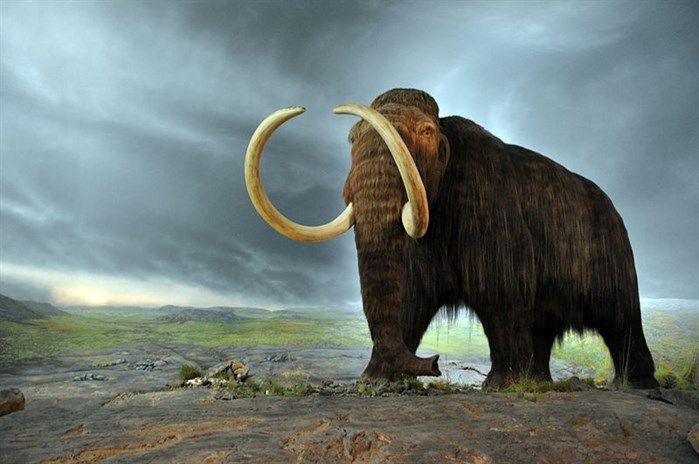
Woolly mammoths roamed around the Thompson Okanagan more than 10,000 years ago.
Image Credit: Wikipedia Commons
August 21, 2021 - 12:02 PM
Travel back in time more than 10,000 years, and you'll see giant mammoths roaming around the Thompson Okanagan.
Evidence of two mammoth species, the woolly mammoth, and the Columbia mammoth, can be found at the Greater Vernon Museum and Archives, said UBC Okanagan professor Robert Young.
The Vernon museum's two mammoth teeth were found in Lumby in 1958, and during an excavation for a new sewer in Vernon in 1971. The museum also has a tusk and two mammoth fossils which are among the oldest pieces in their collection, said collections intern Carolyn Ben.
“Woolly mammoths are actually late arrivals to North America,” Young said, adding they crossed the Bering Ice Bridge that linked Russia to Alaska, 120,000 years ago. “The earlier mammoths got here about 1.6 million years ago,” he said.
The woolly and Columbian mammoths lived together in the Interior during the Pleistocene epoch, he said, but how they became extinct is anyone’s guess.

The Columbian mammoth's history in North America dates back 1.6 million years.
Image Credit: Wikipedia Commons
“For my money, one of the ideas that has the least weight is that people came in with sharp sticks and poked them to death,” he said, adding that humans would have needed “prehistoric bazookas” to actually be able to successfully kill off every mammoth.
At different times of the year, mammoths were probably hunted, but horses were the dominant herbivore during the time of the first humans in North America, he said.
“Most of the horses were the size of ponies and didn’t have sharp horns and things, so they made for good hunting.”
As the glaciers receded, “the world changed,” Young said. “Vast grasslands dried up in the west and to the north, there was more water.”
Vegetation that horses and mammoths couldn’t eat became dominant in the region, he said.
“It probably went from being cold to probably more moist and the vegetation became more capable of producing toxins,” he said.
A mammoth and horse digestive tract is very similar as they primarily digest grass.
Mammoths went extinct roughly 10,000 years ago. Humans have occupied the Interior from anywhere between 10,000 to 12,000 years ago.
READ MORE: Diverse fossil site near Kamloops reopens to the public after 7-year hiatus
And while images of woolly mammoths have been found on cave walls across Europe, it’s harder to say what the Columbian mammoth looked like because cave art wasn’t as common in North America, he said.
“They were relatively hairless, looking more like modern elephants. The woolly mammoths had a number of different accessories. Their trunks were much wider and could be used as snow scoops or to collect water.”
Modern-day elephants need about 20 gallons of water a day, he said.
The woolly mammoth was smaller than the Columbia, he said, which may have been an arctic adaptation. Their teeth alone can weigh as much as 20 pounds each and the mammals could reach a total weight of anywhere between 3,000 to 8,000 pounds.
But not many mammoth fossils have been found in the Interior as the rocks here predate life on earth.
To preserve fossils, organisms have to be buried quickly after death, but the Okanagan doesn’t have the same opportunities for fossil preservation due to its volcanic rock, Young said.
“The Okanagan Valley is actually a tectonic feature from rifting,” Young said, meaning that Earth’s outer crust shifted and created the valley. The valley split apart about 40 million years ago, and magma was able to gush to the surface of the thinner crush. Places like Knox Mountain and Dilworth were once volcanos, he said.
But when mammoths walked the earth, the valley looked quite similar to what it is today. “I don’t think the typography was that startlingly different,” Young said.
See the mammoth fossils for yourself by visiting the Greater Vernon Museum and Archives.
- This story was originally published Feb. 16, 2020.
To contact a reporter for this story, email Carli Berry or call 250-864-7494 or email the editor. You can also submit photos, videos or news tips to the newsroom and be entered to win a monthly prize draw.
We welcome your comments and opinions on our stories but play nice. We won't censor or delete comments unless they contain off-topic statements or links, unnecessary vulgarity, false facts, spam or obviously fake profiles. If you have any concerns about what you see in comments, email the editor in the link above.
News from © iNFOnews, 2021